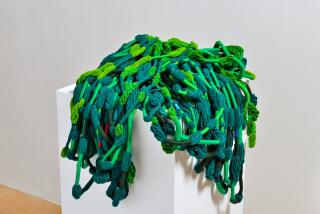AROUND HOME : Notes on Hooked Rugs, Architectural Ornaments and New Books : Hooking Rugs
HOOKED RUGS ARE so much a part of American folk-art history that it seems as though they must have been invented in this country by thrifty colonists who used every shred of fabric and yarn. Not quite: Historians believe that hooked rugs originated in Scandinavia (but they don’t know exactly when), traveled to England and then to the Colonies, where the art flourished for about two centuries, reaching its height of popularity after 1850. When the Industrial Revolution made yarn available, homemakers no longer had to tear up old clothes into tiny strips.
Whether made of scraps, specially dyed strips or purchased yarn, hooked rugs have a comfortable, homey look, and, under bare feet, the loops feel like tiny pebbles.
For today’s hooked rugs, three kinds of hooks and two types of backing fabric are used, with the yarn or strips as varied and individual as they were 300 years ago. The punch needle isn’t really a hook, but a large needle threaded with yarn that literally punches the yarn through loosely woven fabric such as burlap. Worked from the wrong side, the punch-needle method makes a loop on the right side. While being worked, punch-needle rugs must be stretched taut over a frame, and the underside has to be finished with a kind of glue, otherwise, it would unravel at the first touch of the vacuum.
A latchet hook is used with penelope canvas, that is, double-woven needlepoint canvas. Worked from the right side of the piece, the hook pokes through a hole in the canvas, hooks the yarn and pulls it up into a knot with loose ends. The resulting rug can be a tight, short pile, or it can be shaggy, like the rya rugs popular in the 1950s and ‘60s.
Finally there is the plain hook, the traditional tool, which looks like a crochet hook with a big handle. This is wielded from the right side, with the hook pulling the yarn or fabric up into a loop.
Hooked-rug designs are stamped or drawn on the backing fabric: geometrics, florals, animals, color splashes--anything goes. Perhaps the most familiar hooked rugs are the old-fashioned florals with scrolled borders and intricately shaded sprays of flowers. Some collectors and artists, however, believe a hooked rug is defined by American folk art: simply drawn dogs, cats, ponies, houses, even mermaids, often accompanied by exhortations to virtuous behavior. This latter practice perhaps gave early Americans the ambivalent sensation of trampling on the Ten Commandments.
Rug hooking is a simple art, easily learned from books found in the library or from five minutes of instruction by a experienced craftsperson. Latch-hook kits and other rug-hooking supplies are available at Craf-T-Mac’s in La Habra, Lee Wards in Huntington Beach, Yarn Cabin in Anaheim, Art Colony 1 in San Pedro, Nettie’s Needlecraft in Beverly Hills, Needle in the Haystack in Montrose, and Lace and Needle Art in West Hills.


